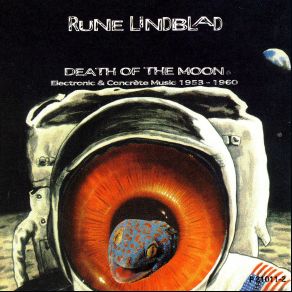Death of the Moon: Electronic and Concrete Music (1953-1960)
Download links and information about Death of the Moon: Electronic and Concrete Music (1953-1960) by Rune Lindblad. This album was released in 1997 and it belongs to Electronica genres. It contains 8 tracks with total duration of 01:13:49 minutes.

|
|
|---|---|
| Artist: | Rune Lindblad |
| Release date: | 1997 |
| Genre: | Electronica |
| Tracks: | 8 |
| Duration: | 01:13:49 |
| Buy it NOW at: | |
| Buy on iTunes $9.99 | |
Tracks
[Edit]| No. | Title | Length |
|---|---|---|
| 1. | Party | 9:36 |
| 2. | Månens Død (Death of the Moon) | 8:33 |
| 3. | Fragment 0 | 9:14 |
| 4. | Fragment 1 | 11:36 |
| 5. | Fragment 2 | 9:59 |
| 6. | Evening | 8:15 |
| 7. | Nocturne | 6:23 |
| 8. | Optica 1 | 10:13 |
Details
[Edit]Born in Sweden in 1923, Rune Lindblad began his unique composing in 1953 by combining electronic music and musique concrète procedures in over 200 works, while also experimenting with woodcuts and painting and using damaged 16mm film in his composition "Optica 1 (Opus 16)." His music was reviewed in 1957 as "pure torture." The eight heavenly tortuous and industrial selections, steady-state tone poems, on this CD are: "Party (Op. 1)," which combines massive layerings of radio transmissions in many languages (" I told him, I told him, well what do you think...das Deutsches Volk...in Deutschland..." and so on) with an intense, sizzling and reverbed layer of random noise and fragments of party-time conversation, all this freely warped by sped-up and slowed-down (largely hand-manipulated) tape and reversed tape techniques, perhaps suggesting that the whole world is a party of sorts. It is difficult to imagine what sound sources were employed for "Månens Död (Death of the Moon) (Op. 2)": there are two competing horn-like/feedback resonance-like melodic lines, interrupted periodically by crashing drums that sound like slowed-down garbage can lids and something that is probably slowed-down knocks on the interior harp of a piano, and a low droning hum underscoring the whole piece...but the effect is very mysterious and archaic, a forgotten netherworld. The opening of "Fragment 0 (Op. 3)" sounds like the material employed for "The Death of the Moon" but at natural speed, and then all hell breaks loose with layers of raw electronic oscillations and crashing and scraping sounds and something like the chattering wooden tongs of a Las Vegas "wheel of fortune" (perhaps a toy) at different rotation speeds. "Fragment 1 (Op. 4)" is also a slowed-down improvisation, but with tiny percussion, glass bottles, shakers, and something like a distorted toy piano. "Fragment 2 (Op. 5)" uses raw waveforms that at first sound like a racing car coming round the oval, then like a buzzsaw, then like transmissions from outer space, then like a surreal train in a tunnel stretching to infinity; "Evening (Op. 7)" is certainly not the tranquil repast the title may suggest, but a wildly explosive sonata of grunge guitar and raw-edged electronics...flying saucers land accompanied by giant insects (my image, none of Lindblad's pieces are accompanied by programs), a '90s downtown improv scene on freely rhythmic electric guitars follows 40 years before its time, electronics enter, and we are out "there" somewhere again. The "Nocturne (Op. 10)" is a frightening experience (I begin to suspect that Lindblad had some kind of cosmic sense of humor)...this is a richly stereophonic piece with the intensity of a Varèse composition, with screaming voices, electronics like volcanic eruptions or solar winds in deep reverb; we're not watching a quiet nighttime sky but experiencing a universe at the boiling point. "Optica 1 (Op. 16)" is an upfront, in-your-face fantasy of raw, wacky, and at the same time boisterously playful electronics. ~ "Blue" Gene Tyranny, Rovi